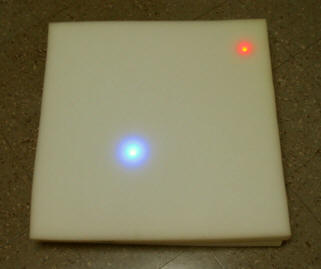 Assume that you are replacing the bearings in the wheel of your
bicycle. To test if you have done a good job, you hold the axle
vertically and give it a spin. The axle at the center of the wheel
is stationary. The wheel as a whole has no
translational motion. But the wheel is turning around
the axle. Every point on the wheel undergoes circular motion about
an axis of rotation. Such motion around an axis of rotation is
called rotational motion.
Assume that you are replacing the bearings in the wheel of your
bicycle. To test if you have done a good job, you hold the axle
vertically and give it a spin. The axle at the center of the wheel
is stationary. The wheel as a whole has no
translational motion. But the wheel is turning around
the axle. Every point on the wheel undergoes circular motion about
an axis of rotation. Such motion around an axis of rotation is
called rotational motion.
Extended object can have translational and
rotational motion. Any motion of an extended object can be viewed
as a combination of translational motion of
the center of mass and rotational motion about the center of mass.
Sponge Toss Movie
Example:
A foam square has a blue LED near its CM and a
red LED near its edge. If we toss the sponge
we can easily observe the parabolic motion
of the CM and the rotational motion about the CM.
How do we describe rotational motion?
Assume you make a chalk mark on the rim of the wheel and you
originally orient the wheel so that the chalk mark is facing you.
This is your reference orientation. The
angular position of the wheel describes its orientation
relative to this reference orientation. As the wheel rotates, this
angular position is changing. The angular
displacement measures how far it has rotated from its
reference orientation. It is often
convenient to orient a coordinate system such that the z-axis
coincides with the axis of rotation and the x-axis defines the
reference orientation. Then the angular displacement
θ of
a point P on the wheel is the angle θ a line from the axis of rotation
to the point P makes with the x-axis.
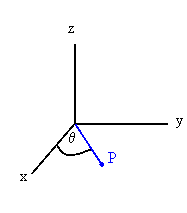 Angles can be measured in units of degrees or
radians. 360 degrees = 2π radians. When describing rotational motion it is most
convenient to measure angles in units of radians.
Angles can be measured in units of degrees or
radians. 360 degrees = 2π radians. When describing rotational motion it is most
convenient to measure angles in units of radians.
To find out how fast the wheel is rotating, we measure its
angular speed ω.
The average angular speed is given by
ωavg = (θf - θi)/(tf
- ti) = Δθ/Δt.
Every point on the wheel has the same angular speed. The
units of angular speed are rad/s or s-1, because
radians are not dimensional.
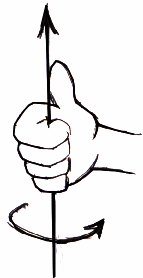 Assume that you turn the axle of the spinning wheel from
vertical to horizontal. The wheel is still spinning with the same
angular speed, but its angular velocity ω has changed. Angular
velocity is a has magnitude and direction.
Its magnitude is the angular speed, and its direction is the
direction of the axis of rotation. There is, however, a subtlety we
have to take care of. Assume that the axis of rotation is
vertical. What is the sense of rotation? Is the wheel spinning
clockwise or counterclockwise as viewed from above? Just saying the
axis is vertical does not tell us the sense
of rotation.
Assume that you turn the axle of the spinning wheel from
vertical to horizontal. The wheel is still spinning with the same
angular speed, but its angular velocity ω has changed. Angular
velocity is a has magnitude and direction.
Its magnitude is the angular speed, and its direction is the
direction of the axis of rotation. There is, however, a subtlety we
have to take care of. Assume that the axis of rotation is
vertical. What is the sense of rotation? Is the wheel spinning
clockwise or counterclockwise as viewed from above? Just saying the
axis is vertical does not tell us the sense
of rotation.
To specify the sense of rotation we use a convention called the
right-hand rule. If the fingers
of your right hand are curling to indicate which way the wheel is
turning, then the thumb of you right hand is pointing in the
direction of the axis of rotation. This is the direction of the
angular velocity ω.
Please click
on the image below for a 3-dimensional view!
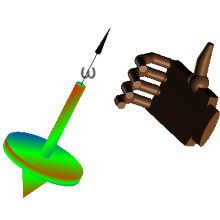
Problem:
What is the average angular speed, in radians per second, of
(a) the Earth in its orbit about
the Sun, and
(b) the Moon in its orbit about the Earth?
Solution:
- Reasoning:
The earth orbits the sun once every year.
The moon orbits the earth once 27.3 days
- Details of the calculation:
(a) The
angular speed of the earth in its orbit about the sun is
ω = 2π/year = 2π/(365*24*60*60 s) = 2*10-7/s.
(b) The
angular speed of the moon in its orbit about the earth
is ω = 2π/(27.3 days) = 2π/(27.3*24*60*60 s) = 2.7*10-6/s.
Angular acceleration
The angular acceleration α
is defined as the rate of change of the
angular velocity. The average angular acceleration is given by
α = (ω2 -
ω1)/(t2 - t1)
= Δω/Δt.
The angular velocity changes when the rotation rate is
increasing or decreasing and when the axis of rotation changes
direction. The angular acceleration is a vector.
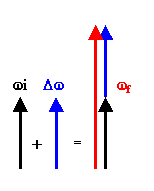 If we change the number of revolutions
the wheel makes per second, then each point on the wheel
has angular acceleration. Assume the angular velocity points in the
z-direction, and over a one second time interval we change the angular speed of
the wheel from π/s to 2π/s. The average angular acceleration is
If we change the number of revolutions
the wheel makes per second, then each point on the wheel
has angular acceleration. Assume the angular velocity points in the
z-direction, and over a one second time interval we change the angular speed of
the wheel from π/s to 2π/s. The average angular acceleration is
α = (ω2 -
ω1)/(t2
- t1) = ((2π/s
- π/s) k/(1s) = (π/s2)k,
i.e. it has magnitude π/s and points in the z-direction.
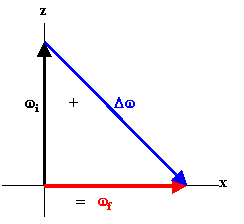 If we turn the axis of
rotation from vertical to horizontal, then each point on the wheel
has angular acceleration. Assume the wheel is rotating with angular
velocity (2π/s)k
about the z-axis. If over a time interval of 1 s we reorient the axis of rotation from
vertical to horizontal, so that the wheel is now rotating with angular velocity (2π/s)i about the x-axis, then the
average angular acceleration is given
by
If we turn the axis of
rotation from vertical to horizontal, then each point on the wheel
has angular acceleration. Assume the wheel is rotating with angular
velocity (2π/s)k
about the z-axis. If over a time interval of 1 s we reorient the axis of rotation from
vertical to horizontal, so that the wheel is now rotating with angular velocity (2π/s)i about the x-axis, then the
average angular acceleration is given
by
α = (ω2 -
ω1)/(t2
- t1) = ((2π/s i - 2π/s
k) /(1s).
The magnitude is
(√2)2π and its direction makes an angle of 315o with the x-axis.
Problem:
What is the magnitude of the angular velocity,
ω, of the second hand of a clock?
What is the direction of ω as
you view a clock hanging vertically? What is the magnitude of
the angular acceleration of the second hand?
Solution:
- Reasoning:
The second hand of a clock goes through an angular
displacement of 2π in one
minute. Its angular speed is ω = 2π/(60 s) = 0.105/s. The direction
of ω is
perpendicular to the face of the clock, pointing into the
face of the clock. The average angular acceleration of
the second hand is zero.
 Assume that you are replacing the bearings in the wheel of your
bicycle. To test if you have done a good job, you hold the axle
vertically and give it a spin. The axle at the center of the wheel
is stationary. The wheel as a whole has no
translational motion. But the wheel is turning around
the axle. Every point on the wheel undergoes circular motion about
an axis of rotation. Such motion around an axis of rotation is
called rotational motion.
Assume that you are replacing the bearings in the wheel of your
bicycle. To test if you have done a good job, you hold the axle
vertically and give it a spin. The axle at the center of the wheel
is stationary. The wheel as a whole has no
translational motion. But the wheel is turning around
the axle. Every point on the wheel undergoes circular motion about
an axis of rotation. Such motion around an axis of rotation is
called rotational motion. Angles can be measured in units of degrees or
radians. 360 degrees = 2π radians. When describing rotational motion it is most
convenient to measure angles in units of radians.
Angles can be measured in units of degrees or
radians. 360 degrees = 2π radians. When describing rotational motion it is most
convenient to measure angles in units of radians.  Assume that you turn the axle of the spinning wheel from
vertical to horizontal. The wheel is still spinning with the same
angular speed, but its angular velocity ω has changed. Angular
velocity is a has magnitude and direction.
Its magnitude is the angular speed, and its direction is the
direction of the axis of rotation. There is, however, a subtlety we
have to take care of. Assume that the axis of rotation is
vertical. What is the sense of rotation? Is the wheel spinning
clockwise or counterclockwise as viewed from above? Just saying the
axis is vertical does not tell us the sense
of rotation.
Assume that you turn the axle of the spinning wheel from
vertical to horizontal. The wheel is still spinning with the same
angular speed, but its angular velocity ω has changed. Angular
velocity is a has magnitude and direction.
Its magnitude is the angular speed, and its direction is the
direction of the axis of rotation. There is, however, a subtlety we
have to take care of. Assume that the axis of rotation is
vertical. What is the sense of rotation? Is the wheel spinning
clockwise or counterclockwise as viewed from above? Just saying the
axis is vertical does not tell us the sense
of rotation.

 If we change the number of revolutions
the wheel makes per second, then each point on the wheel
has angular acceleration. Assume the angular velocity points in the
z-direction, and over a one second time interval we change the angular speed of
the wheel from π/s to 2π/s. The average angular acceleration is
If we change the number of revolutions
the wheel makes per second, then each point on the wheel
has angular acceleration. Assume the angular velocity points in the
z-direction, and over a one second time interval we change the angular speed of
the wheel from π/s to 2π/s. The average angular acceleration is
 If we turn the axis of
rotation from vertical to horizontal, then each point on the wheel
has angular acceleration. Assume the wheel is rotating with angular
velocity (2π/s)k
about the z-axis. If over a time interval of 1 s we reorient the axis of rotation from
vertical to horizontal, so that the wheel is now rotating with angular velocity (2π/s)i about the x-axis, then the
average angular acceleration is given
by
If we turn the axis of
rotation from vertical to horizontal, then each point on the wheel
has angular acceleration. Assume the wheel is rotating with angular
velocity (2π/s)k
about the z-axis. If over a time interval of 1 s we reorient the axis of rotation from
vertical to horizontal, so that the wheel is now rotating with angular velocity (2π/s)i about the x-axis, then the
average angular acceleration is given
by